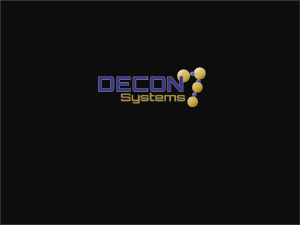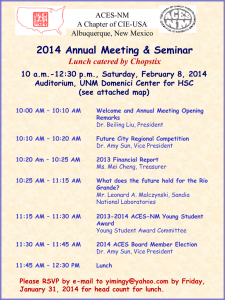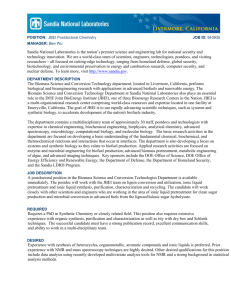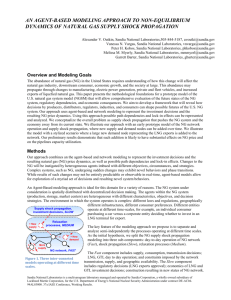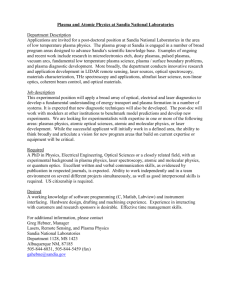National Science Foundation 4201 Wilson Boulevard Arlington
advertisement
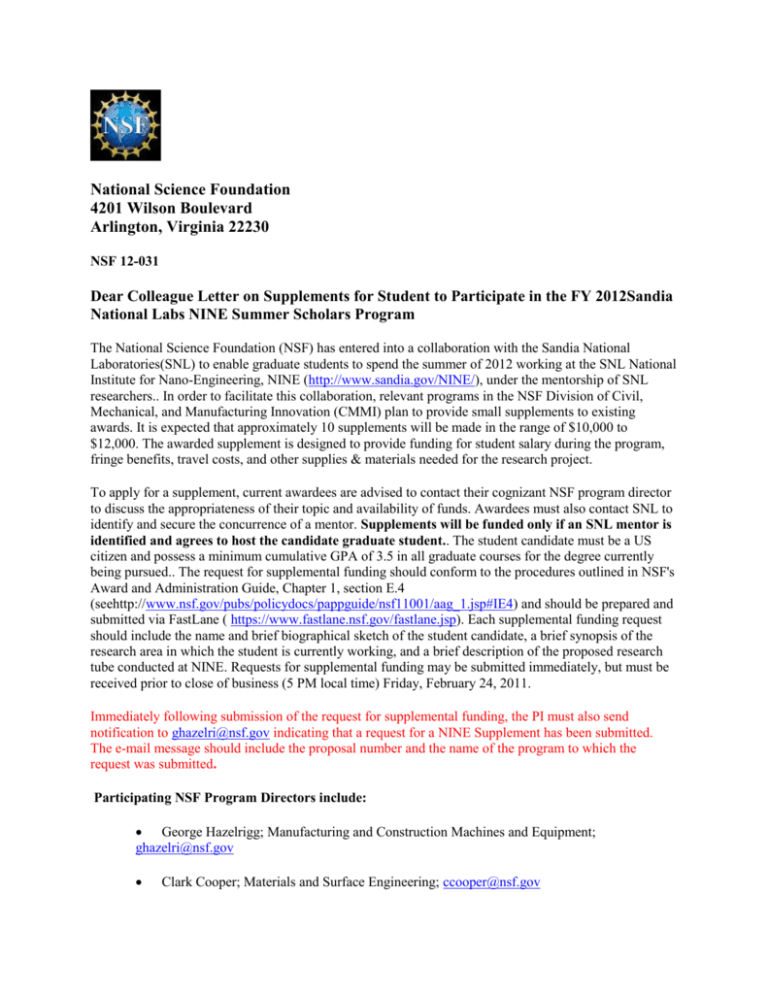
National Science Foundation 4201 Wilson Boulevard Arlington, Virginia 22230 NSF 12-031 Dear Colleague Letter on Supplements for Student to Participate in the FY 2012Sandia National Labs NINE Summer Scholars Program The National Science Foundation (NSF) has entered into a collaboration with the Sandia National Laboratories(SNL) to enable graduate students to spend the summer of 2012 working at the SNL National Institute for Nano-Engineering, NINE (http://www.sandia.gov/NINE/), under the mentorship of SNL researchers.. In order to facilitate this collaboration, relevant programs in the NSF Division of Civil, Mechanical, and Manufacturing Innovation (CMMI) plan to provide small supplements to existing awards. It is expected that approximately 10 supplements will be made in the range of $10,000 to $12,000. The awarded supplement is designed to provide funding for student salary during the program, fringe benefits, travel costs, and other supplies & materials needed for the research project. To apply for a supplement, current awardees are advised to contact their cognizant NSF program director to discuss the appropriateness of their topic and availability of funds. Awardees must also contact SNL to identify and secure the concurrence of a mentor. Supplements will be funded only if an SNL mentor is identified and agrees to host the candidate graduate student.. The student candidate must be a US citizen and possess a minimum cumulative GPA of 3.5 in all graduate courses for the degree currently being pursued.. The request for supplemental funding should conform to the procedures outlined in NSF's Award and Administration Guide, Chapter 1, section E.4 (seehttp://www.nsf.gov/pubs/policydocs/pappguide/nsf11001/aag_1.jsp#IE4) and should be prepared and submitted via FastLane ( https://www.fastlane.nsf.gov/fastlane.jsp). Each supplemental funding request should include the name and brief biographical sketch of the student candidate, a brief synopsis of the research area in which the student is currently working, and a brief description of the proposed research tube conducted at NINE. Requests for supplemental funding may be submitted immediately, but must be received prior to close of business (5 PM local time) Friday, February 24, 2011. Immediately following submission of the request for supplemental funding, the PI must also send notification to ghazelri@nsf.gov indicating that a request for a NINE Supplement has been submitted. The e-mail message should include the proposal number and the name of the program to which the request was submitted. Participating NSF Program Directors include: George Hazelrigg; Manufacturing and Construction Machines and Equipment; ghazelri@nsf.gov Clark Cooper; Materials and Surface Engineering; ccooper@nsf.gov Dennis Carter; Biomechanics and Mechanobiology; dcarter@nsf.gov Mary Toney; Materials Processing and Manufacturing; mtoney@nsf.gov Bruce Kramer; Nanomanufacturing; bkramer@nsf.gov Martin Dunn; Mechanics of Materials; mdunn@nsf.gov Eduardo Misawa; Dynamical Systems; emisawa@nsf.gov Christina Bloebaum; Engineering Design and Innovation; cbloebau@nsf.gov Kishor Mehta; Hazard Mitigation and Structural Engineering; kimehta@nsf.gov Interested researchers who have awards in programs not listed above are encouraged to contact the cognizant NSF PD and inquire about the suitability of a supplemental funding request. Funding decisions will be based on the relevance of the topic area, the availability of an SNL mentor, the quality of the student, and the availability of funds. The SNL contact for this opportunity is Regan Stinnett(rwstinn@sandia.gov). Appearing below is a list of potential SNL mentors: Current NINE Points-of-Contact (prospective mentors) and Technical Areas of Interest: Todd Alam (tmalam@sandia.gov, 505-844-1225), NMR characterization of nano-materials Mark Allendorf (mdallen@sandia.gov, 925-294-2895), Stress-Induced Chemical Detection Using Flexible Coordination Polymers and Nanofunctionalized Sensors Chris Apblett (capable@sandia.gov, 505-272-7125) Jim Aubert (jhauber@sandia.gov, 505-844-4481), Nano-materials characterization Edward Barnat (evbarna@sandia.gov, 505-284-9828) Low temperature, non-equilibrium plasma based processes, plasma source design and plasma diagnostics. Matt Blain (blainmg@sandia.gov, 505-844-4020), Micro and Nano Photonics, Quantum Information Processing. Tim Boyle (tiboyle@sandia.gov, 505-272-7625), Responsive Nanocomposites Geoff Brennecka (glbrenn@sandia.gov, 505-845-0105), Nanostructured ceramics and polymers for integrated electronics applications Igal Brener (ibrener@sandia.gov, 505-844-8097), Modeling, Simulation and Fabrication of Optical Metamaterials and Nanoplasmonic structures for novel nano-optics. Jeff Brinker (cjbrink@sandia.gov, 505-272-7627), Self-assembly and Surface Functionality Susan Brozik (smbrozi@sandia.gov, 505-844-5105), and Ronen Polsky (rpolsky@sandia.gov, 505-845- 3672) Development of new nanostructures for sensing applications including the use of various lithographic techniques to make structures in conducting materials. This includes work with photoresist and ormocer materials, materials modifications to design novel sensing platforms, and integration of sensing systems with drug delivery systems and microfluidics. Bruce Burckel (dbburck@sandia.gov, 505-284-9983), Phase Imprint Lithography for Large Area 3D Nanostructures Mat Celina (mccelin@sandia.gov, 505-845-3551), Production and Applications of Nanostructured Polymers and Polymer-based Nanocomposites, barrier coatings for PV Shawn Dirk (smdirk@sandia.gov, 505-844-7835), Electrospinning, nano-encapsulation, novel dielectrics for supercapacitors, nanostructured membranes, smart nanostructured materials for electronic packaging, functional organic coatings for nano-enabled sensors Sidney Elmer (spelmer@sandia.gov, 925-294-6134) Molecular dynamics simulations of enzyme dynamics; protein design and engineering Hongyou Fan (hfan@sandia.gov, 505-272-7128), Self-assembly of patterned micelle arrays Jeff Greathouse (jagreat@sandia.gov, 925-284-4895), Stress-Induced Chemical Detection Using Flexible Coordination Polymers Gary Grest (gsgrest@sandia.gov, 505-844-3261), Modeling and simulation at the nanoscale, nanocomposites Anne Grillet (amgrill@sandia.gov, 505-844-7453), Nanoparticle-Stablized Emulsions and Manufacture of Ceramic Foams Liz Holm (eaholm@sandia.gov, 505-844-7669), Nanocrystalline Bulk and Thin Film Materials: Experiment and Modeling Jianyu Huang (jhuang@sandia.gov, 505-844-0403), Developing a Thermal Microscopy Platform for In- Situ Thermal/Thermoelectric structure-property studies of individual nanotubes and nanowires Dale Huber (dhuber@sandia.gov, 505-844-9194). Magnetic nanoparticles: Synthesis, characterization, and functionalization for biomedical applications. Jon Ihlefeld (jihlefeld@sandia.gov, 505-844-3162), Electroceramic materials for energy harvesting and storage. Rick Kemp (rakemp@sandia.gov, 505-272-7609), and Jim Miller (jemille@sandia.gov, 505272-7626), Fundamentals of Synthetic Conversion of CO2 to Simple Hydrocarbon Fuels Using Nano-catalysis. Jeremy Lechman, (jblechm@sandia.gov, 505-844-7129), Atomistic energy dissipation mechanisms at nanoscale, high rate impact of nano-particles, coarse-grained model development of high-strain rate, high-energy, nanocomposite deformation Kevin Leung (kleung@sandia.gov, 505-844-1588), Improving Electronic Structure Calculations to Predict Nano-optoelectronics and Nanocatalyst Functions Francois Leonard (fleon@sandia.gov, 925-294-3511), Carbon Nanotube Thin Film Solar Cells Kevin McCarty (mccarty@sandia.gov, 925-294-2067), Graphene electronics enabled by epitaxial growth on metal substrates. Matthew Marinela (mmarine@sandia.gov, 505-844-7848), Electrical characterization of metal/insulator/metal memristor structures made in-house and obtained externally. Knowledge of standard semiconductor electrical characterization techniques and equipment is useful. Todd Monson (tmonson@sandia.gov, 505-845-2129), Synthesis and characterization of magnetic and ferroelectric nanoparticles and related device applications. David Moehring (dimoehr@sandia.gov, 505-844-1106), Designing, building, and testing microfabricated surface ion traps for quantum information processing. Jeremy Palmer (japalme@sandia.gov, 505-284-8400), Surface Treatments for Wire Bond Strength in Laminate BGA Packages and ALD Diffusion Barrier Coatings for PBGA Substrates. David Robinson (drobins@sandia.gov, 925-294-6613), Nanoporous metals for hydrogen storage, electrical energy storage, chemical separations, and drug delivery. Bernadette Hernandez-Sanchez (baherna@sandia.gov, 505-272-7656), Semiconducting nanocrystals Randy Schunk (prschu@sandia.gov, 505-844-5992), Nanoscale Modeling & Simulation: Impact on Nano-Engineering John Shelnutt (jasheln@sandia.gov, 505-272-7160), Nanostructured Electrocatalysts for Solar Fuel Production and Fuel Cells Mike Siegal (mpsiega@sandia.gov, 505-845-9453), Carbon nanotube chirality, CNT-based thermal interface materials, thermoelectric nanowires, nanoporous-carbon sorbent coatings for chemicaldetection, nanoporous-carbon for energy storage. Jack Skinner (jlskinn@sandia.gov, 925-294-2398), Electronics & Optoelectronics of Nanowires,Nanotubes, & Patterned Material Erik Spoerke (edspoer@sandia.gov, 505-284-1932), Soft Nanomaterials, Nano-composites, and Interfaces Regan Stinnett (rwstinn@sandia.gov, 505-284-4841), General NINE information John Sullivan (jpsulli@sandia.gov, 505-845-9496), Integrating and Characterizing Nanoscale Materials with platforms to measure their mechanical, thermal, electrical, or electrochemical properties. Hartono (Anton) Sumali (hsumali@sandia.gov, 505-844-7918), Atomic Force Microscope, mechanical properties of cells and viruses, and effects of impacts on surface tolography Larry Stotts (lgstott@sandia.gov, 505-844-6807), Micro-Total-Analytical Systems Brian Swartzentruber (bsswart@sandia.gov, 505-844-6393), "Bottom-up" Meets "Topdown:" Self-assembly to Direct Manipulation of Nanostructures on Length Scales from Atoms to Microns Cody Washburn (cmwashb@sanida.gov, 505-845-2074), High Surface Area polymer-based nanoporous materials Kevin Zavadil (krzavad@sandia.gov, 505-845-8442), Nanoscale Electrochemistry for Energy and Energy Storage
